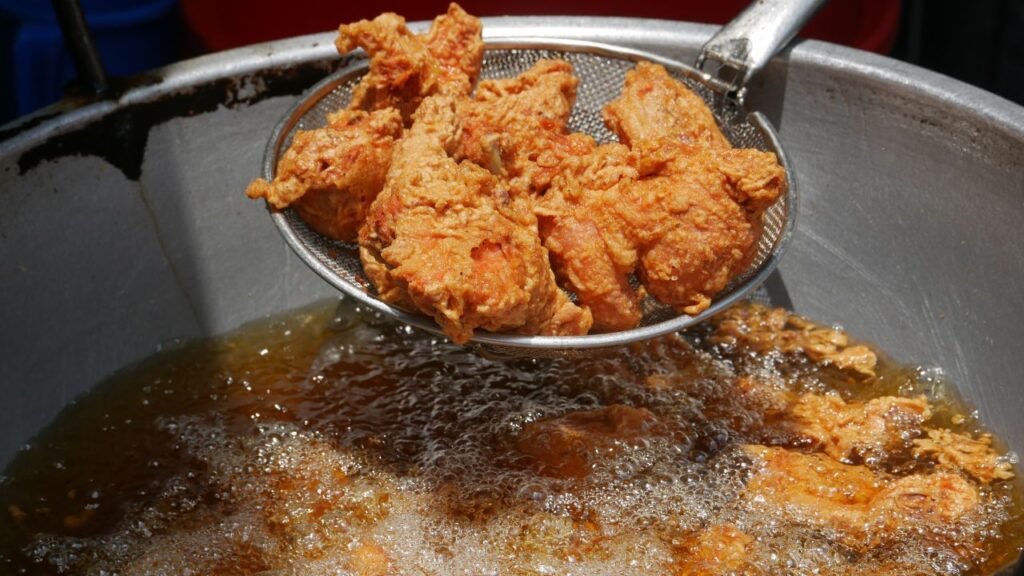
When I first started cooking on my own, I made the mistake that many beginners do – I thought chicken was just chicken, regardless of how I prepared it. Boy, was I wrong! After years of experimenting and researching, I’ve learned that the way you cook your chicken can be just as important as the quality of the meat itself. Discover the healthiest ways to cook chicken with our expert guide.
The cooking method you choose affects everything from calorie count to nutrient retention. Think about it – a piece of grilled chicken breast and a deep-fried chicken wing from the same bird might as well be completely different foods nutritionally!
What makes a cooking method “healthy” really comes down to three main factors: how much fat you’re adding during cooking, how well the method preserves the chicken’s natural nutrients, and whether it creates any potentially harmful compounds in the process. The good news? You don’t have to sacrifice flavor for health. I’ve found that some of the healthiest cooking methods actually enhance chicken’s natural taste.
I remember when I switched from pan-frying to poaching chicken for my weekly meal prep. Not only did I cut calories significantly, but I discovered the meat was actually more tender and juicy. That’s the kind of win-win we’re looking for in healthy cooking!
In this guide, I’ll walk you through 12 different ways to cook chicken, ranking them from most to least healthy. Whether you’re a busy parent looking for quick weeknight dinner solutions or a fitness enthusiast tracking your macros, you’ll find practical advice for making healthier chicken dishes that don’t compromise on taste.
The Healthiest Chicken Cooking Methods Ranked
When it comes to cooking chicken in the healthiest way possible, not all methods are created equal. I’ve spent years experimenting with different techniques, and I’ve ranked them based on nutrition retention, added fats, and the formation of potentially harmful compounds.
Contents
- 1 Poaching: The Gentle Approach
- 2 Steaming: Lock in Moisture and Nutrients
- 3 Sous Vide: Precision Healthy Cooking
- 4 Pressure Cooking: Fast and Nutritious
- 5 Grilling: Healthy When Done Right
- 6 Baking: Convenient and Healthy
- 7 Air Frying: The Healthier “Fried” Alternative
- 8 Deep Frying: Why It’s Problematic
- 9 Sautéing: Making It Healthier
- 10 The Role of Skin: On or Off?
- 11 Marinades, Rubs, and Seasonings: Healthy Choices
- 12 Temperature and Timing: Finding the Sweet Spot
- 13 Herb-Infused Poached Chicken Breast
- 14 Asian-Inspired Steamed Chicken with Vegetables
- 15 Perfect Sous Vide Chicken Breasts
- 16 Is boiling chicken healthier than baking?
- 17 Does removing the skin make chicken significantly healthier?
- 18 Can marinating chicken make it healthier?
- 19 Is air-fried chicken actually healthy or just healthier than deep-fried?
- 20 How can I make sure my chicken is cooked safely without drying it out?
- 21 Which herbs and spices are best for healthy chicken recipes?
- 22 Is rotisserie chicken from the store a healthy option?
Poaching: The Gentle Approach
Poaching has become my go-to method when I want the healthiest possible chicken. This gentle, moist-heat cooking technique involves submerging chicken in liquid (usually water or broth) and cooking it at a low temperature until it’s done.
Why I love poaching:
- It adds zero fat to your chicken
- The gentle heat preserves more nutrients than high-heat methods
- It keeps chicken incredibly moist and tender
- The cooking liquid becomes infused with flavor you can use for soups or sauces
I’ve found that poaching works best with boneless, skinless chicken breasts, though you can certainly poach any cut. For extra flavor without adding calories, I often add aromatics to my poaching liquid – garlic cloves, bay leaves, peppercorns, and herbs work wonders.
Pro tip: Keep the liquid at a bare simmer, never a rolling boil. You should see just a few small bubbles rising to the surface. This low-temperature approach is key to keeping the meat tender.
Steaming: Lock in Moisture and Nutrients
Steaming chicken might sound bland, but I discovered it’s actually one of the best ways to preserve both flavor and nutrition. Like poaching, steaming uses moist heat, but the food isn’t submerged in liquid.
The benefits I’ve experienced with steaming:
- No added fat required
- Excellent nutrient retention
- Maintains the chicken’s natural flavor
- Keeps the meat incredibly juicy
You don’t need fancy equipment to steam chicken – I started with a simple metal colander over a pot of boiling water covered with a lid. Now I use a bamboo steamer, which I find adds a subtle, pleasant aroma to the chicken.
For the best results, I’ve found that boneless cuts work better than bone-in pieces, and adding aromatics to the steaming water infuses the chicken with delicate flavor.
Sous Vide: Precision Healthy Cooking
When I first heard about sous vide cooking, I was skeptical – it seemed like a fancy technique for professional chefs. But once I tried it, I was amazed by how perfectly the chicken turned out every single time.
Sous vide involves sealing food in a plastic bag and cooking it in a water bath at a precisely controlled temperature. Here’s why it ranks so high on my healthy cooking list:
- Zero added fat needed
- Precise temperature control means no overcooked, dry meat
- Maximum nutrient retention
- Perfect texture and moisture every time
I started sous vide cooking without special equipment by using the cooler method: seal chicken in a ziplock bag, remove the air, and place it in a cooler filled with water at your target temperature. I’d add hot water periodically to maintain the temperature. Now I use an inexpensive sous vide immersion circulator that makes the process even easier.
Chicken breasts cooked sous vide at 145°F (62.8°C) for at least 1.5 hours are perfectly safe and incredibly tender – a revelation compared to the often dry, overcooked chicken breasts I used to make.
Pressure Cooking: Fast and Nutritious
When I discovered pressure cooking, it completely changed my weeknight dinner game. This method uses steam under pressure to cook food quickly while preserving nutrients – something I find particularly valuable on busy days.
The benefits I’ve experienced with pressure cooking chicken:
- Significantly faster cooking times (about 1/3 the time of conventional methods)
- Excellent retention of vitamins and minerals
- Creates tender, fall-off-the-bone texture
- Works wonderfully with tougher, more economical cuts
I started with a stovetop pressure cooker years ago, but I’ve since switched to an electric multi-cooker that makes the process even more hands-off. The sealed environment keeps nutrients and flavors locked in, resulting in chicken that’s both healthy and delicious.
For the best results, I’ve found that bone-in, skin-on chicken pieces work beautifully in the pressure cooker. The bones add flavor, and you can always remove the skin before eating if you’re watching fat intake. My favorite pressure cooker chicken dish uses a simple blend of herbs, lemon, and garlic – the flavors really penetrate the meat in the pressurized environment.

Grilling: Healthy When Done Right
There’s nothing quite like the flavor of grilled chicken, and when done properly, it can be a very healthy cooking method. I’ve learned that the key is managing the heat and using the right techniques to avoid creating harmful compounds.
Why grilling can be a healthy choice:
- Excess fat drips away from the meat
- No added oil needed for cooking
- Creates satisfying flavor without sauces
- Can be done year-round (indoor or outdoor grills)
To make grilling healthier, I follow these practices:
- Marinate chicken in acid-based mixtures (lemon juice, vinegar) to reduce formation of HCAs (heterocyclic amines)
- Keep the grill clean to prevent buildup of potentially harmful residue
- Avoid charring or burning the meat
- Choose leaner cuts or remove skin before eating
I find that chicken thighs work wonderfully on the grill – they’re more forgiving than breasts and less likely to dry out, while still being relatively lean when trimmed.
Baking: Convenient and Healthy
Baking might seem basic, but I’ve found it to be one of the most versatile and reliable healthy cooking methods in my kitchen. With the right approach, baked chicken can be moist, flavorful, and very nutritious.
The advantages I’ve found with baking:
- Requires minimal added fat
- Even, consistent cooking
- Works with any cut of chicken
- Allows for endless flavor variations
For the healthiest baked chicken, I’ve learned a few key techniques:
- Use parchment paper instead of oil to prevent sticking
- Bake at the right temperature (usually 350-375°F) to maintain juiciness
- Create a packet or tent with foil or parchment to lock in moisture
- Use herbs, spices, and aromatics for flavor instead of high-calorie sauces
One of my favorite weeknight meals is a sheet pan dinner with chicken breasts and seasonal vegetables, all tossed with herbs and a tiny bit of heart-healthy olive oil. It’s a complete meal that’s both nutritious and easy to clean up!
Air Frying: The Healthier “Fried” Alternative
When I first bought an air fryer, I was skeptical that it could produce crispy chicken without all the oil. I was pleasantly surprised to discover that it actually works! Air frying has become one of my favorite ways to satisfy cravings for crispy chicken in a much healthier way.
What I’ve learned about air frying chicken:
- Uses up to 80% less oil than traditional frying
- Creates a satisfying crispy exterior
- Cooks food quickly and evenly
- Works well for reheating chicken without drying it out
To get the best results in my air fryer, I lightly spray chicken with olive oil rather than submerging it in oil. For chicken with skin, the natural fat renders out and helps create that crispy texture without adding extra oil.
My air fryer has been particularly great for cooking chicken wings and tenders in a healthier way. My kids actually prefer my air-fried chicken tenders to the deep-fried fast food version, which I consider a major win!
Unhealthy Cooking Methods to Avoid or Modify
In my cooking journey, I’ve learned that some popular chicken cooking methods can undermine your health goals. Rather than eliminating these entirely, I’ve found ways to modify them for better nutrition.

Deep Frying: Why It’s Problematic
I’ll be honest – I love the taste of deep-fried chicken. But after researching its health impacts, I’ve reserved it for rare treats rather than regular meals. Here’s why:
- Adds significant calories through oil absorption (a single piece can add 200+ calories from oil alone)
- Creates potentially harmful compounds at high temperatures
- Destroys many heat-sensitive nutrients
- Often involves breading that adds refined carbs and sodium
If you absolutely must have that deep-fried taste, I’ve found some healthier alternatives:
- Use the air fryer method mentioned earlier
- Try “oven-frying” with a light coating of oil and breadcrumbs
- Make smaller portions of the real thing as an occasional treat
- Choose healthier oils like avocado oil that can withstand high heat better
Sautéing: Making It Healthier
Sautéing is my weeknight dinner savior, but standard sautéing can add quite a bit of oil to your meal. Here’s how I’ve modified this method to be healthier:
- Use a high-quality non-stick pan to reduce the amount of oil needed
- Measure oil with a teaspoon rather than freestyle pouring
- Try water or broth sautéing for zero added fat
- Choose heart-healthy oils like olive oil when you do use fat
I’ve found that slicing chicken thinly helps it cook quickly with minimal oil. Adding vegetables to the same pan creates a complete meal while distributing the small amount of oil across more food.
Key Factors That Affect Chicken’s Nutritional Value
The Role of Skin: On or Off?
The chicken skin question used to confuse me until I looked at the numbers. Here’s what I learned:
- Chicken skin is where much of the fat is concentrated
- A 3-oz chicken breast with skin contains about 7g fat; without skin, only 3g
- The skin adds about 25-30 extra calories per 3-oz serving
- However, some fat-soluble vitamins reside in the skin
My personal approach: I often cook with the skin on to keep the meat moist, then remove it before eating for everyday meals. For special occasions, I might enjoy the crispy skin as a treat.
Marinades, Rubs, and Seasonings: Healthy Choices
I’ve discovered that the right marinades and seasonings not only make chicken delicious but can actually make it healthier:
- Acid-based marinades (lemon juice, vinegar, yogurt) can reduce formation of harmful compounds during high-heat cooking
- Herbs and spices add antioxidants and anti-inflammatory compounds
- The right seasonings can reduce the need for salt
My go-to healthy marinade combines lemon juice, garlic, herbs, and a small amount of olive oil. I’ve found that even 15-30 minutes of marinating makes a difference in both flavor and health properties.
Rubs made with spices like turmeric, black pepper, garlic powder, and paprika add significant antioxidant power with zero calories. I make big batches to keep on hand for quick flavor.
Temperature and Timing: Finding the Sweet Spot
Getting the temperature and timing right has been critical for both safety and nutrition in my kitchen:
- Undercooked chicken poses serious food safety risks
- Overcooked chicken becomes dry and loses nutrients
- Different cuts require different cooking times
I always use a meat thermometer to ensure chicken reaches the safe internal temperature of 165°F (74°C). For chicken breasts, I’ve learned to take them off the heat at 160°F as they’ll continue cooking to reach the safe temperature while resting.
Bone-in cuts take longer but stay moister. I’ve found that dark meat (thighs, legs) is more forgiving of longer cooking times than white meat (breasts), which can quickly become dry when overcooked.
Healthy Chicken Recipes Using Top Methods
After years of experimenting, I’ve developed a collection of go-to healthy chicken recipes that use the cooking methods we’ve discussed. Here are some of my favorites that demonstrate how healthy cooking can also be delicious and satisfying.
Herb-Infused Poached Chicken Breast
This is my favorite weekday lunch prep recipe – it’s simple, versatile, and creates tender chicken plus a bonus broth.
Ingredients:
- 1 lb boneless, skinless chicken breasts
- 4 cups low-sodium chicken broth (or water)
- 2 garlic cloves, smashed
- 1 bay leaf
- 4 sprigs fresh thyme
- 1 lemon, sliced
- 1 teaspoon peppercorns
- Salt to taste
Instructions:
- Place all ingredients in a wide pot or deep skillet
- Bring to a gentle simmer (not a boil)
- Cover and cook for 10-15 minutes until chicken reaches 165°F
- Let chicken rest in the liquid for 5 minutes
- Slice and use in salads, sandwiches, or grain bowls
I often double this recipe to have protein ready for the whole week. The resulting broth makes an excellent base for soups or cooking grains.
Asian-Inspired Steamed Chicken with Vegetables
This complete meal comes together quickly while preserving all the nutrients in both the chicken and vegetables.
Ingredients:
- 1 lb boneless chicken thighs, cut into strips
- 2 cups mixed vegetables (broccoli, carrots, snow peas)
- 1 tablespoon low-sodium soy sauce
- 1 tablespoon rice vinegar
- 1 teaspoon sesame oil
- 1 teaspoon grated ginger
- 2 garlic cloves, minced
- Red pepper flakes to taste
Instructions:
- Toss chicken with half the soy sauce, vinegar, and garlic
- Arrange vegetables in a steamer basket
- Place chicken on top of vegetables
- Steam for 10-12 minutes until chicken is cooked through
- Mix remaining ingredients for a quick sauce
- Drizzle sauce over the chicken and vegetables before serving
I serve this over brown rice or cauliflower rice for a complete meal that’s full of protein and vegetables.
Perfect Sous Vide Chicken Breasts
Since getting my sous vide circulator, this has become my go-to method for the juiciest chicken breasts ever.
Ingredients:
- 2 boneless, skinless chicken breasts
- 1 tablespoon olive oil
- 2 teaspoons fresh herbs (rosemary, thyme, oregano)
- 1 garlic clove, sliced
- Salt and pepper to taste
- Lemon zest (optional)
Instructions:
- Set sous vide water bath to 145°F (62.8°C)
- Season chicken with salt, pepper, and herbs
- Place in a ziplock bag with garlic and optional lemon zest
- Remove air using water displacement method and seal
- Cook for 1.5-2 hours
- Optional: Sear quickly in a hot pan for color
- Slice and serve
The texture difference between traditional baked chicken breast and sous vide is remarkable – it’s changed how I view chicken breast completely.
Conclusion: Balancing Health, Flavor, and Convenience
After trying countless methods for cooking chicken over the years, I’ve come to understand that the “healthiest” method isn’t just about nutrition – it’s about finding the sweet spot between health, flavor, and what actually works in your real life.
For me, that often means batch-cooking chicken using gentle methods like poaching or sous vide on weekends, then incorporating it into quick meals throughout the week. On busy weeknights, I might rely on the pressure cooker or air fryer to get dinner on the table quickly without sacrificing nutrition.
The key takeaways I’ve learned:
- Lower-temperature, moist-heat methods generally preserve the most nutrients
- Adding healthy fats in moderation can actually help your body absorb certain nutrients
- The healthiest cooking method is ultimately the one you’ll actually use consistently
- Simple herbs, spices, and acid-based marinades can boost both flavor and nutrition
I encourage you to experiment with different methods to find what works for your taste preferences, equipment, and schedule. Remember that even small improvements to your cooking methods can add up to significant health benefits over time.
Whether you’re a busy parent, a fitness enthusiast, or someone just trying to eat a bit better, I hope these insights help you enjoy chicken that’s both delicious and nutritious.
FAQs About Healthy Chicken Cooking
Is boiling chicken healthier than baking?
When I first started cooking, I assumed boiling was always healthiest because it adds no fat. But I’ve learned it’s not that simple. Boiling (or more accurately, poaching) can be very healthy, but it can also leach water-soluble B vitamins and minerals into the cooking water. If you use that cooking liquid in soups or sauces, you’ll recapture most of those nutrients.
Baking can be just as healthy when done without added fats, and it often produces more flavorful results. I find that gentle poaching works best for chicken I’ll use in salads or cold dishes, while baking works better when I want more flavor development.
Does removing the skin make chicken significantly healthier?
After looking at the nutrition data, I can confidently say yes – removing the skin does make a significant difference. When I analyzed the numbers, I found that a 3-ounce portion of chicken breast with skin has about 167 calories and 7g of fat, while the same portion without skin has only 142 calories and 3g of fat.
That said, I’ve found that cooking with the skin on helps keep the meat moist and flavorful. My compromise is to cook with the skin on, then remove it before eating for everyday meals.
Can marinating chicken make it healthier?
This was a fascinating discovery for me – yes, certain marinades actually can make chicken healthier! Research shows that acid-based marinades (using ingredients like lemon juice, vinegar, or yogurt) can reduce the formation of potentially harmful compounds called heterocyclic amines (HCAs) by up to 90% when grilling or broiling.
Additionally, herbs and spices in marinades contribute antioxidants. However, I’m careful with marinades high in sugar, salt, or oil, as these can add calories and sodium.
Is air-fried chicken actually healthy or just healthier than deep-fried?
When I first got an air fryer, I wondered this exact thing. After using it regularly, I’d say air-fried chicken falls somewhere in the middle of the health spectrum. It’s significantly healthier than deep-fried chicken, using up to 80% less oil. However, it’s not as healthy as steamed or poached chicken.
I see it as a good compromise when I’m craving that crispy texture. To make air-fried chicken as healthy as possible, I use minimal oil spray and avoid pre-packaged breading mixes that can add sodium and refined carbs.
How can I make sure my chicken is cooked safely without drying it out?
This was my biggest challenge when I started cooking chicken! The solution that changed everything for me was investing in an inexpensive meat thermometer. This lets me cook chicken to the safe internal temperature of 165°F (74°C) without guessing or overcooking.
I’ve also learned that for chicken breasts, you can remove them from heat at 160°F, as carryover cooking will bring them to the safe temperature while resting. Brining chicken breasts (soaking in salt water) for even 15 minutes before cooking also helps them stay moist.
Which herbs and spices are best for healthy chicken recipes?
Through both research and personal experience, I’ve found that certain herbs and spices not only make chicken delicious but add genuine health benefits:
- Turmeric contains curcumin, a powerful anti-inflammatory compound (I always add black pepper with it to increase absorption)
- Garlic has antibacterial and heart-healthy properties
- Oregano and thyme contain antioxidants and antimicrobial compounds
- Rosemary has compounds that may help with digestion and inflammation
- Ginger can help with nausea and has anti-inflammatory properties
These all add flavor without calories or sodium, making them excellent choices for healthy chicken dishes.
Is rotisserie chicken from the store a healthy option?
As a busy person, I often rely on store-bought rotisserie chicken, so I’ve researched this thoroughly. The answer is: it can be relatively healthy, especially if you remove the skin. However, many commercial versions contain added sodium and sometimes sugar or other additives.
When possible, I check the ingredient list and look for options with minimal additives. Some stores now offer organic or “natural” versions with simpler ingredients. I find that using store-bought rotisserie chicken as a starting point for homemade soups, salads, and grain bowls is a reasonable compromise between convenience and health.

